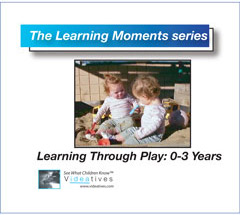ExchangeEveryDay Past Issues
 << Previous Issue
| View Past Issues | | Next Issue >>
<< Previous Issue
| View Past Issues | | Next Issue >> High-Tech Toys
January 27, 2011
Are we forming children who are only capable of learning what is known, or should we try to develop creative and innovative minds?
-Jean Piaget
-Jean Piaget
A great example of this can be seen in a short video from one of our new "Learning Moments CDs." If you check out this clip, you will see a 10-month-old infant learning about the limits of support by placing a ball on a platform and then carefully moving it to the edge to watch it fall. He works at this diligently on his own, without beeping noises or flashing lights to reward his effort. He is learning.

These Learning Moments discs (for use on a computer) present real-life video files that are the perfect compliment to workshops, lectures, and online courses on how young children learn through play. They make general principles of child development and early education come to life by revealing children's natural process of discovery, invention, and learning.
ExchangeEveryDay
Delivered five days a week containing news, success stories, solutions, trend reports, and much more.
What is ExchangeEveryDay?
ExchangeEveryDay is the official electronic newsletter for Exchange Press. It is delivered five days a week containing news stories, success stories, solutions, trend reports, and much more.
Parents love the messaging and security features of EZ-CARE2's TimeClock. You’ll love how it saves time, reduces costs, and eliminates manual tasks!

Julie Bartkus, Speaker, Author, and Staff Motivation Expert shares with you how to create the POSITIVE and PRODUCTIVE workplace that you desire and deserve.
Limited Offer – grab yours today.


Comments (4)
Displaying All 4 CommentsKids Kastle Day Care & Preschool
Grants Pass, Oregon, United States
Sorry, I couldn't even watch the clip throughout without stopping to write about the the huge fish tank on the floor behind the child. Not exactly a safe environment from where I see it. It kind of loses any credibility for for teaching anybody else anything, in my opinion.
New Hartford, NY, United States
I applaud this writer's effort to drive the point home that children need to be "allowed" to explore, to draw conclusions, and to make inferences about the world around them by accessing their own individual resources and manipulating their environment. She calls this learning and by definition it is.
I also feel that it is important to note that beeping sounds and flashing lights have their place in the broad spectrum of learning dimensions. For example, when a parents applauds a child's efforts or shrieks "yay" when a baby takes his or her first steps, some might argue that this provides a feedback similar to beeping sounds and flashing lights (from a behaviorist perspective). Different children learn different ways, and most children learn most ways. Clearly there is learning taking place when a child presses buttons to spell cat, and successfully transfers that information over to mom or dad later that evening. I would argue that the bells and whistles has more to do with the child learning the word cat, than just seeing the three letters spelled out on the screen.
Let's be careful about providing a tunnel visioned approach to learning. Technology is not going anywhere.....we need to leverage it (intelligently, responsibly, and open-mindedly) in an effort to provide personally meaningful learning opportunities for our children.
Shishu Vikash Kendra
Kolkata, West Bengal, India
In the time of IT High-Tech-Toys are needed
Macky and michael\\\\\\\\\\\\\\\\\\\\\\\\\\\\\\\\\\\\\\\\\\\\\\
Cambridge, MA, United States
great video!
Post a Comment